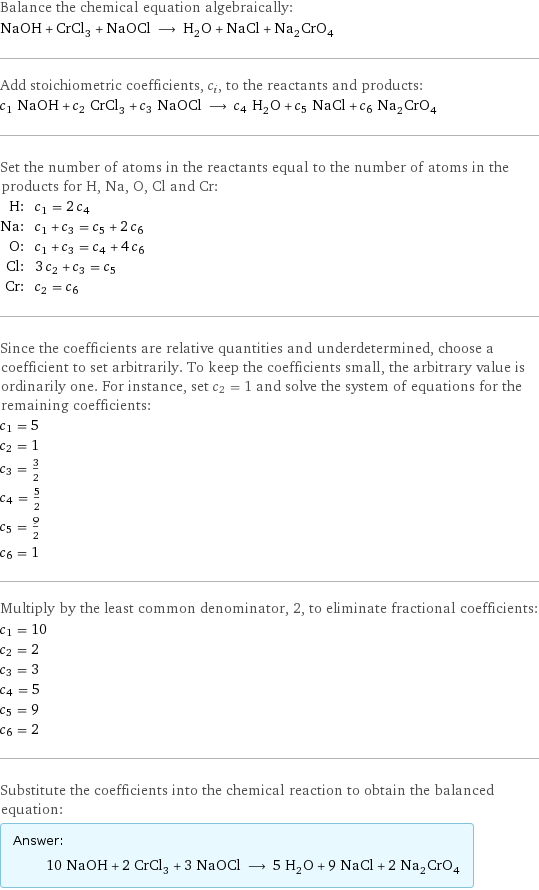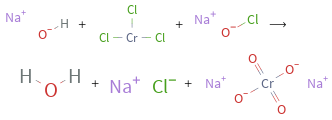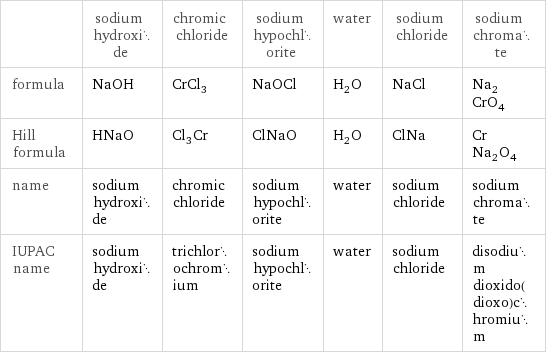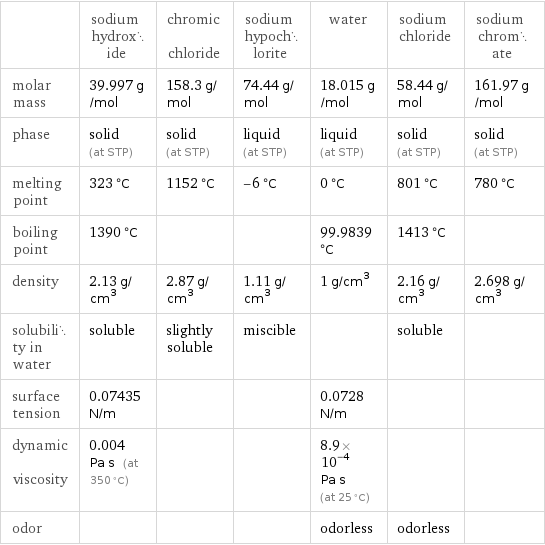Input interpretation

NaOH (sodium hydroxide) + CrCl_3 (chromic chloride) + NaOCl (sodium hypochlorite) ⟶ H_2O (water) + NaCl (sodium chloride) + Na_2CrO_4 (sodium chromate)
Balanced equation

Balance the chemical equation algebraically: NaOH + CrCl_3 + NaOCl ⟶ H_2O + NaCl + Na_2CrO_4 Add stoichiometric coefficients, c_i, to the reactants and products: c_1 NaOH + c_2 CrCl_3 + c_3 NaOCl ⟶ c_4 H_2O + c_5 NaCl + c_6 Na_2CrO_4 Set the number of atoms in the reactants equal to the number of atoms in the products for H, Na, O, Cl and Cr: H: | c_1 = 2 c_4 Na: | c_1 + c_3 = c_5 + 2 c_6 O: | c_1 + c_3 = c_4 + 4 c_6 Cl: | 3 c_2 + c_3 = c_5 Cr: | c_2 = c_6 Since the coefficients are relative quantities and underdetermined, choose a coefficient to set arbitrarily. To keep the coefficients small, the arbitrary value is ordinarily one. For instance, set c_2 = 1 and solve the system of equations for the remaining coefficients: c_1 = 5 c_2 = 1 c_3 = 3/2 c_4 = 5/2 c_5 = 9/2 c_6 = 1 Multiply by the least common denominator, 2, to eliminate fractional coefficients: c_1 = 10 c_2 = 2 c_3 = 3 c_4 = 5 c_5 = 9 c_6 = 2 Substitute the coefficients into the chemical reaction to obtain the balanced equation: Answer: | | 10 NaOH + 2 CrCl_3 + 3 NaOCl ⟶ 5 H_2O + 9 NaCl + 2 Na_2CrO_4
Structures

+ + ⟶ + +
Names

sodium hydroxide + chromic chloride + sodium hypochlorite ⟶ water + sodium chloride + sodium chromate
Equilibrium constant
![K_c = ([H2O]^5 [NaCl]^9 [Na2CrO4]^2)/([NaOH]^10 [CrCl3]^2 [NaOCl]^3)](../image_source/f20d02283c2739e4f3b252a021dcbc38.png)
K_c = ([H2O]^5 [NaCl]^9 [Na2CrO4]^2)/([NaOH]^10 [CrCl3]^2 [NaOCl]^3)
Rate of reaction
![rate = -1/10 (Δ[NaOH])/(Δt) = -1/2 (Δ[CrCl3])/(Δt) = -1/3 (Δ[NaOCl])/(Δt) = 1/5 (Δ[H2O])/(Δt) = 1/9 (Δ[NaCl])/(Δt) = 1/2 (Δ[Na2CrO4])/(Δt) (assuming constant volume and no accumulation of intermediates or side products)](../image_source/75bdb9745a4381ee221497637cb28f63.png)
rate = -1/10 (Δ[NaOH])/(Δt) = -1/2 (Δ[CrCl3])/(Δt) = -1/3 (Δ[NaOCl])/(Δt) = 1/5 (Δ[H2O])/(Δt) = 1/9 (Δ[NaCl])/(Δt) = 1/2 (Δ[Na2CrO4])/(Δt) (assuming constant volume and no accumulation of intermediates or side products)
Chemical names and formulas

| sodium hydroxide | chromic chloride | sodium hypochlorite | water | sodium chloride | sodium chromate formula | NaOH | CrCl_3 | NaOCl | H_2O | NaCl | Na_2CrO_4 Hill formula | HNaO | Cl_3Cr | ClNaO | H_2O | ClNa | CrNa_2O_4 name | sodium hydroxide | chromic chloride | sodium hypochlorite | water | sodium chloride | sodium chromate IUPAC name | sodium hydroxide | trichlorochromium | sodium hypochlorite | water | sodium chloride | disodium dioxido(dioxo)chromium
Substance properties

| sodium hydroxide | chromic chloride | sodium hypochlorite | water | sodium chloride | sodium chromate molar mass | 39.997 g/mol | 158.3 g/mol | 74.44 g/mol | 18.015 g/mol | 58.44 g/mol | 161.97 g/mol phase | solid (at STP) | solid (at STP) | liquid (at STP) | liquid (at STP) | solid (at STP) | solid (at STP) melting point | 323 °C | 1152 °C | -6 °C | 0 °C | 801 °C | 780 °C boiling point | 1390 °C | | | 99.9839 °C | 1413 °C | density | 2.13 g/cm^3 | 2.87 g/cm^3 | 1.11 g/cm^3 | 1 g/cm^3 | 2.16 g/cm^3 | 2.698 g/cm^3 solubility in water | soluble | slightly soluble | miscible | | soluble | surface tension | 0.07435 N/m | | | 0.0728 N/m | | dynamic viscosity | 0.004 Pa s (at 350 °C) | | | 8.9×10^-4 Pa s (at 25 °C) | | odor | | | | odorless | odorless |
Units
